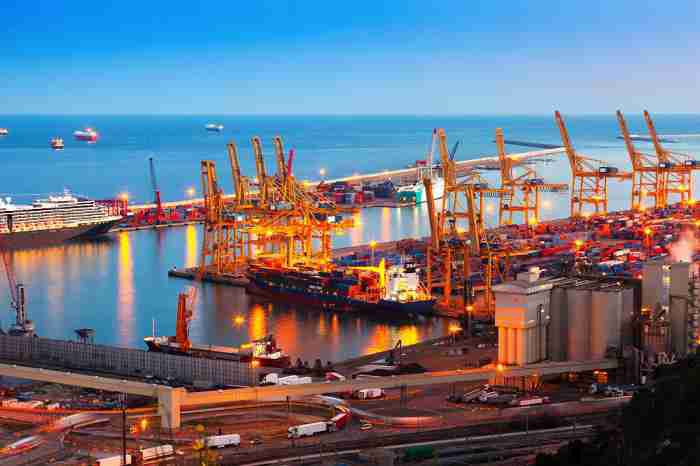
Effective supply chain management and logistics are essential to a company's success in today's global economy. The most significant of these challenges, port congestion and capacity management, have emerged due to the global supply chain's increasing complexity and management challenges.
In this blog, we'll look at the causes and effects of port congestion, especially concerning shipping by sea from India, and we'll talk about effective mitigation techniques.
Understanding Global Supply Chain Management
Managing the entire supply chain, from the point of origin to the final destination, entails coordinating and integrating numerous tasks. It includes all aspects of production, transportation, warehousing, and sourcing. Effective logistics and transportation systems, especially regarding sea freight, are crucial to the smooth operation of the global supply chain.
Sea Shipping from India: Importance and Challenges
India is a major producer and exporter on the global stage, and it heavily relies on sea shipping to reach foreign markets. India's overall trade volume is largely comprised of maritime transportation. However, port congestion and capacity management issues result from the rising demand for sea freight services, infrastructure constraints, and operational inefficiencies.
Causes of Port Congestion
- Growing Trade Volumes: The ever-growing volume of global trade has put tremendous pressure on ports to handle more cargo, which has caused congestion.
- Limitations: Limited berths, inadequate storage facilities, and outdated equipment are all examples of inadequate infrastructure that reduces the handling capacity and contributes to port congestion.
- Ineffective Operations: Delays and bottlenecks at ports can be caused by ineffective stakeholder coordination, a lack of standardized processes, and out-of-date operational procedures.
- Customs and Regulatory Issues: Prolonged customs clearance procedures, documentation requirements, and difficult regulatory processes can lead to delays and congestion at ports.
Consequences of Port Congestion
- Delays and Extended Transit Times: Port congestion reduces the effectiveness of the supply chain by increasing transit times, delaying cargo loading and unloading, and lengthening vessel waiting times.
- Rising Costs: Delays brought on by traffic congestion can increase demurrage fees, storage costs, and transportation costs, which can have an effect on business profitability.
- Transit times: Long transit times and erratic delays make inventory planning and management difficult, which could result in stockouts or an excess of inventory.
- Customer Dissatisfaction: Delayed deliveries and unpredictably long transit times may have a negative effect on consumers' opinions of brands and their loyalty to those brands.
Strategies for Effective Capacity Management
- Collaboration and Communication: Effective capacity management requires improved communication and collaboration between port authorities, shipping lines, terminal operators, and logistics providers. Stakeholders can anticipate and address capacity constraints with the aid of timely and accurate information sharing.
- Infrastructure Investments: To increase operational efficiency, governments and port authorities should invest in constructing new berths, updating existing machinery, and implementing cutting-edge technologies.
- Optimized Terminal Operations: By implementing advanced terminal operating systems (TOS), automating processes, and going digital, you can increase operational effectiveness, speed up turnaround times, and better manage capacity.
- Prioritize Trade Facilitation: To speed up the movement of goods, governments should concentrate on streamlining customs clearance procedures, making documentation requirements simpler, and investing in technologies like electronic data interchange (EDI).
- Diversification of Modes of Transportation: By looking into alternate transportation methods, such as rail and inland waterways, one can reduce their reliance on seaports and ease traffic.
Businesses must actively manage their supply chain and logistics operations in addition to the previously mentioned tactics to navigate port congestion successfully. Here are a few more pointers:
- Demand Forecasting and Inventory Management: To minimize the effects of port congestion, accurate demand forecasting and inventory management procedures are essential. Businesses that closely monitor market trends, work with suppliers, and employ just-in-time inventory strategies can reduce the costs associated with holding inventory and maximize stock levels.
- Flexible Sourcing and Supplier Collaboration: Building solid relationships with suppliers and looking into alternate sourcing possibilities can help businesses adjust to the shifting conditions brought on by port congestion.
- Shipment Optimization: Consolidating shipments and optimizing them can help decrease the number of individual containers handled, which relieves port congestion.
- Real-Time Tracking and Visibility: Using cutting-edge technologies for tracking and visibility, such as Internet of Things (IoT) gadgets and global supply chain management, gives you instantaneous information about the whereabouts and status of your shipments.
Conclusion
In today's global supply chain, navigating port congestion and efficiently managing capacity is a challenging task that calls for cooperation from all parties. Given the growing demand for sea shipping from India and to international markets, it is essential to find solutions to the issues brought on by port congestion. By understanding the causes and consequences of congestion, businesses can implement strategies to mitigate its impact on their supply chain operations.
Furthermore, it is impossible to overstate the significance of effective capacity management. Infrastructure improvements, improved terminal operations, streamlined trade facilitation procedures, and mode diversification are all necessary.
Businesses can handle the challenges of sea shipping from India and optimize ocean freight rates with the help of FreightMango's comprehensive solution, which provides end-to-end visibility, collaboration tools, and advanced analytics. You can effectively manage your supply chain with FreightMango, reduce the effects of port congestion, and improve operational effectiveness.





 Get instant quote
and compare offers in real time
Get instant quote
and compare offers in real time